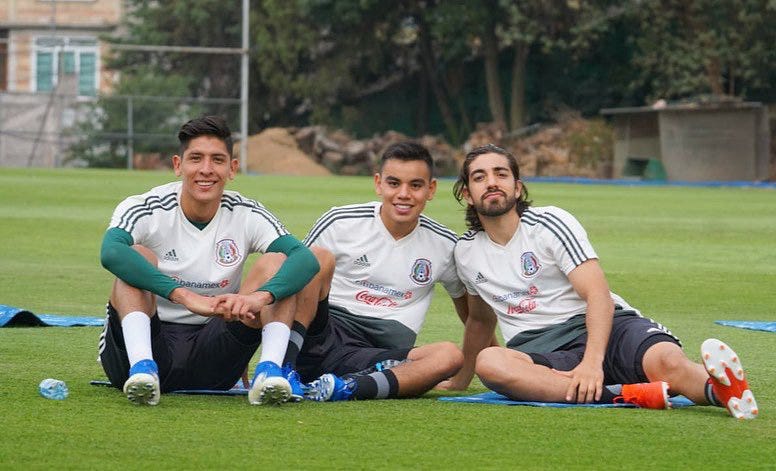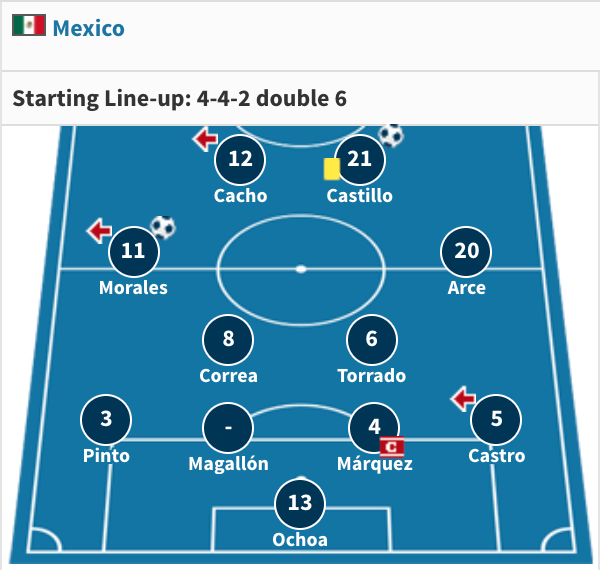11 Thoughts on the beginnings of El Tri's summer
What El Tri's results this summer will suggest for what's to come
I apologize for not being active the past couple of weeks. The U-20 disaster had the writing on the wall from the get-go. An unfortunate tournament, led by a manager who fared very poorly against some of the best U-20 opposition in the World Cup. I expected more tactical mobility from Diego Ramírez, but I hardly spotted any. The direction of Mexico youth teams is uncertain, coping with a transformation that includes a considerable number of departures and arrivals, while Gerardo “Tata” Martino awaits to see how his first half of 2019 as México manager will turn out. The conclusions from March were more positive than negative, so with that in mind, here we go with this week’s, the first of June, 11 Thoughts.

11 Thoughts
1. I’d like to find out why Ramírez and Jaime Lozano have been convinced to use the 4-4-2 shape. Against Italy, Ramírez set up an XI that included Roberto de la Rosa and José Juan Macías upfront, while Lozano did the same in the debut against Bahrain in the Maurice Revello Tournament by including Paolo Yrizar and Jesús Godínez as the two strikers up top. With the U-20s we know how the story ended, and at least with Lozano’s México team, they started the tournament with a win and draw in a group that includes China, Bahrain and Ireland. But I’ll admit that there’s still a lot of work to do for Lozano’s side, which over 180 minutes has lacked attacking spark. The best attacking spark so far has come from Alan Mozo, the team’s right-back, and Jairo Torres, the left-winger.
2. If there’s a national team that gets the best out of a 4-4-2 shape, it has to be Uruguay. In the last World Cup we saw it several times. For example in the Round of Sixteen 2-1 win over Portugal, Uruguay’s four midfielders included — Lucas Torreira, Matias Vecino, Naitan Nández and Rodrigo Bentancur. The two strikers up top were none other than Edinson Cavani and Luis Suárez. The movements from that team were a variation of starting plays from the inside and then finding ways to move the ball outside, to the wings. Cavani and Suárez’s movements were all over the attacking half, and in certain plays the full-backs Diego Laxalt and Martín Cáceres made appearances in the final third that finished with them crossing into the box. It’s a system that Uruguay understands and has players to make it work. I feel that with El Tri, it’s very difficult to assemble this type of playing style, but it’s one that deserves thought, especially as means to have legitimate options of winning against opponents like Sweden or opponents that clearly have better players than El Tri.
3. Everyone remembers that game in which Nery Castillo scored that phenomenal golazo against Brazil in the 2007 Copa América, well, in that game El Tri played with a 4-4-2. El Tri won 2-0, and it helped that they scored twice in a span of six minutes. The formation looked something like this:

As you can see, it wasn’t a star-studded line-up, but the midfield had something that allowed it to flourish, which is that all four options — Ramoncito Morales, Jaime Correa, Gerardo Torrado and Fernando Arce — had the ability to interiorizar. In other words, they had no trouble playing in the center of the midfield. Morales and Arce were the most capable to start plays from the flanks, while Correa and Torrado stayed in the middle to disrupt play. But it also helped that in defense El Tri had someone like Rafa Márquez, whose skills on the ball were hard to match by any Mexican defender available. Let’s not forget, too, and this one is important, that Guillermo Ochoa had an impeccable game, filled with important saves. What I remember from this match is that El Tri was able to suffer and could have won the game 3-0, without displaying a possession-based style of play. It’s remarkable to look back and realize that El Tri’s forwards were Juan Carlos Cacho and Castillo and to think that they actually developed an interesting scoring tandem.
4. With all that being said, it’s important to note how many styles El Tri has to comprehend in order to master its own style. What styles fit the Mexican footballers? Because in CONCACAF play, it’s incomprehensible to see El Tri play with a 4-4-2 or even a 5-3-2 formation. We can’t forget the 2015 Gold Cup, in which El Tri struggled mainly because its 5-3-2 formation was turning to stagnate, allowing opponents to take advantage of the team’s predictability. And we can’t forget how awful El Tri looked under “Chepo” de la Torre’s watch as it kept using a 4-4-2 formation against CONCACAF sides that hardly created any offensive threat. But we have seen against tougher sides, predominantly European and South American, that a 5-3-2 formation is a good style to have, mainly because it gives off the feeling that it allows El Tri to compete and stay in the game.
5. One of the playing aspects Juan Carlos Osorio’s reign left behind is the influence of the wing-play. The play in the flanks for the Mexican national team took a different color with Osorio because as he noted many times, his wingers did the attacking while his full-backs remained in the back to keep defensive balance. It was a very structured 4-3-3 at times, with very little surprise factor, especially with the full-backs not appearing that much in the final third. With Martino, I have the belief that the 4-3-3 will take a different route because I do think the full-backs will get more touches on the ball. Also with Rodolfo Pizarro and Raúl Jiménez as the main attackers, there’s going to be a lot of mobility upfront because these two like getting touches in different areas. What remains to be seen is who will take Chucky’s place in the Gold Cup XI? And who has the skills to fulfill his role on the field?
6. This idea of bringing the 4-4-2 into play, might just be a random thought I have, but I do find it interesting that Lozano and Ramírez used it with their respective teams during the last weeks. All this string of thoughts goes back to the notion of having tactical mobility. There’s a lot of specific events in a 90-minute game, and the opponent has a lot to do with it. In that quarterfinal match between Paraguay and Spain, which La Roja went on to win 1-0, Martino started the game with a 4-4-2 formation. So what I’m trying to say is this: it’s good for El Tri’s youth teams to test styles of play and even fail at attempting them because at the end of the day, what matters is the World Cup performance. The next one is in 2022. However, I do believe that with Martino we’re seeing that the 4-3-3 formation is working very well. I did express my frustrations last week on how bad the U-20 looked, perhaps it could have been better, maybe the team didn’t have the best available U-20 talent, maybe Ramírez needed to react quicker and realize that players like Lainez, Antonio Figueroa, Misael Domínguez and Macías don’t feel comfortable in a 4-4-2 shape. That’s probably the main problem that needs to be emphasized, if you’re going to use the 4-4-2 formation, there has to be complete certainty that the players you have available can execute it. I think that’s where Ramírez failed — in understanding that he didn’t have the talent to play the 4-4-2 although he kept going at it.
7. Finally. We got a chance to see Fernando Navarro with El Tri. One of the aspects that best stood out in the 3-1 win over Venezuela was how many touches the full-backs got in the in the final third. Navarro’s crossing into the box was dangerous in almost all his tries, but what stood out the most was his ability to interpret the spaces. Whenever Roberto Alvarado got on the ball and moved to the edge of the right flank, Navarro always looked to move to open space in order to become another passing/scoring option. His skill to know where to move in the box is going to make him an intriguing option for Martino, and the competition for minutes against “Chaka” Rodríguez and Jorge Sánchez will be fierce. But it wasn’t only Navarro who gave a good performance, I really enjoyed how Jesús Gallardo played with and without the ball; he looked loose, and with a good interpretation of what he had to complete on the pitch. With Martino, the full-backs will take a more important role when it comes to plays in the final third, and it’s probably why El Tri’s manager sees it better to send Uriel Antuna back to Los Angeles, where he’ll continue on getting important playing time with Guillermo Barros Schelotto.
8. Rodolfo Pizarro’s playing with a lot of swag, and with every game, his influence in Martino’s team grows. Carlos Vela is right when he says that the generation that’s coming right behind his is good, and Pizarro is a big reason why that Vela statement makes sense. Although he might not show it, Pizarro is a winner who has won titles in three very different Liga MX sides. His recipe is pretty simple, if you show him that you trust him and have confidence in him, he’ll respond on the field. His partnership with Jiménez will need more repetitions in order to create more danger in the final third.
9. Edson Álvarez will not miss the Gold Cup, and that’s good news for El Tri. We’re in the early stages of the Martino era, but it has been very clear how much Martino trusts Edson’s defensive midfield abilities. With him on the field, it seems that the team plays with more intensity, and that will be helpful in years to come. His climb in México national teams has been meteoric.
10. When Orbelín Pineda came onto the pitch, Martino made sure to give him pointers on where he had to position himself. All of a sudden, with all the absentees in the national team, his presence will be important. I look forward on seeing him get more opportunities in the forward positions. With Martino, Pineda will be taking on the same role that he had when he made his debut with Víctor Manuel Vucetich’s Querétaro. If Martino can help Pineda score a couple of goals like these during the Gold Cup, consider it a huge success:
11. El Tri’s Gold Cup roster will include seven players who participated in the last Gold Cup, which was a tournament Osorio used to make tactical tests. The players are Erick Gutiérrez, Orbelín, Chaka, Edson, César Montes, Pizarro and Gallardo. Other U-23 players in the list are Sánchez and Alvarado, who last summer participated in the Toulon Tournament. Twenty-one-year-old Alexis Vega has been chosen by Martino and his coaching staff to be the second striker in the roster, while 22-year-old Charly Rodríguez keeps giving excellent performances with El Tri, which will make it difficult to take him off the starting line-up. What the Atlanta game proved is that Martino is enjoying the opportunity to work with a young base of Mexican footballers and getting wins along the way.


